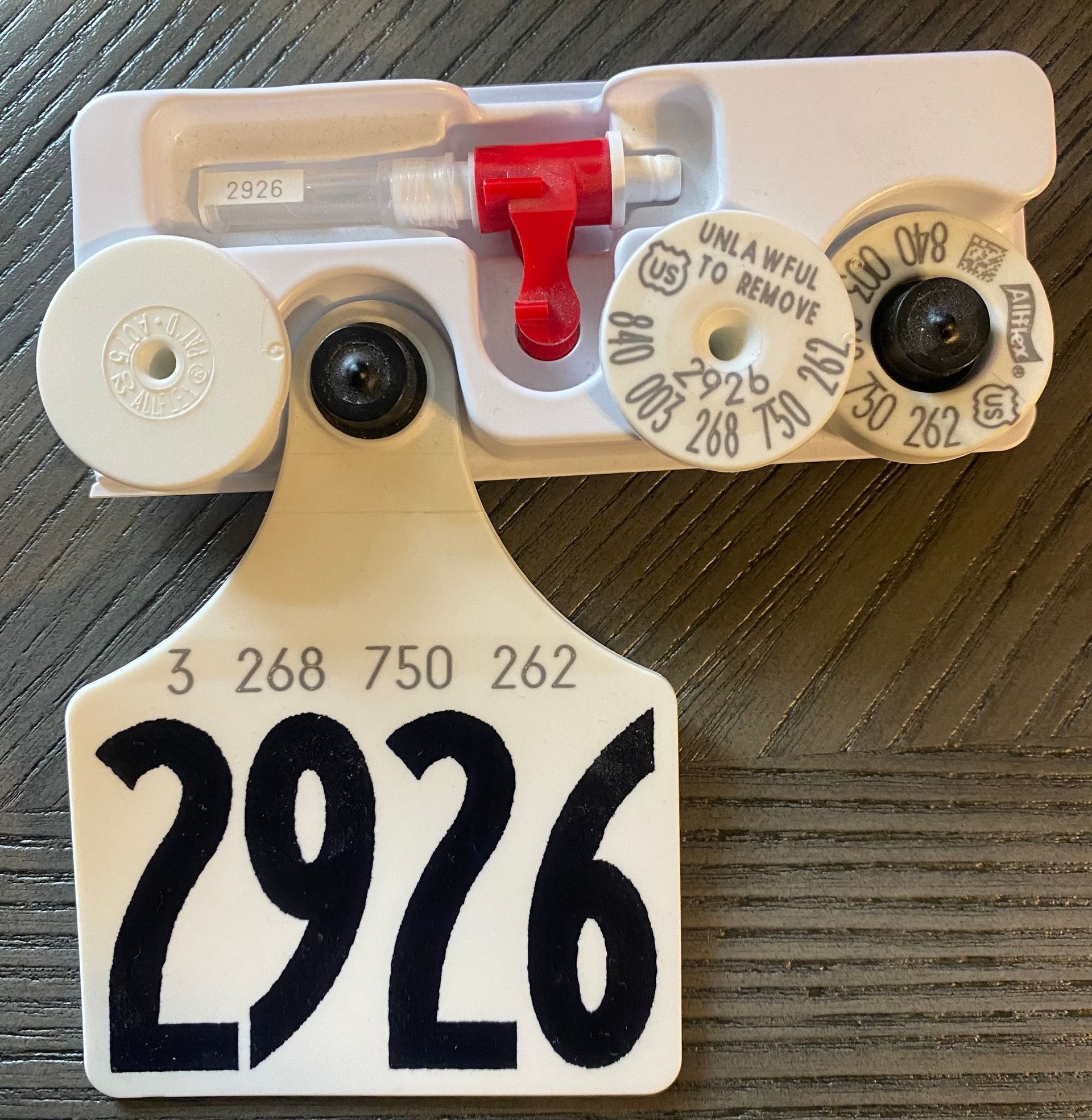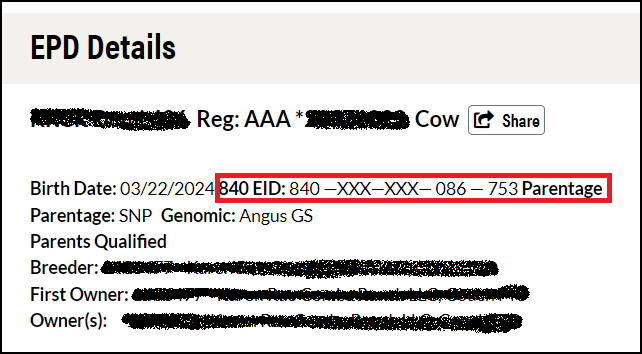Efficiency and Accuracy: The Rise of Electronic ID Tags in Livestock Management
Efficiency and Accuracy:
The Rise of Electronic ID Tags in Livestock Management


Exploring EID Tag Options: From Standalone to Matched Sets
When exploring EID tags, there are several options to consider. You can choose standalone EID tags, order them paired with visual tags, or opt for a matched pair set that includes a tissue sampling unit (TSU), where all components are perfectly matched for streamlined identification and sample collection.
Brinkley Angus Ranch, located in Milan, MO, has opted to use the matched pair set, which includes the EID tag, a visual tag, and a tissue sampling unit (TSU). If you closely examine the single tag picture, you'll notice that the number "2926" is displayed on all components of the matched pair set, including the EID, the visual tag, and the TSU. This setup provides the ranch with an efficient, all-in-one solution for cattle identification and DNA sampling, ensuring consistency across their herd management system.
Rule 105 in the Breeder’s Reference Guide was amended in September 2022 to allow electronic identification (EID) as the primary form of identification for Angus cattle. If EID is used as the primary identifier, it must be paired with a secondary form of identification. Acceptable secondary identifiers include parentage markers, tattoos, freeze brands, hot brands, or visual tags. This rule change has given Ranchers the opportunity to use an EID as their primary form of identification whereas before this wasn’t the case.
Calving Records and EIDs: Managing Data from Birth to Weaning
There are a couple of ways to add EID to the animal records at the American Angus Association. If you are using the Registration Entry form, change the Primary ID to "840 EID." This will open the necessary fields to submit the 840 EID and the secondary identification.

Check with your tag supplier to see if they offer a downloadable file. This can save you time and reduce errors. For instance, Brinkley Angus Ranch purchased their matched pair sets from AllFlex, which provides the ability to download a file containing information from the set, including the 840 number, the Management Code, and the Bag ID.
If you have already submitted the calving information to the Association, you can use a spreadsheet option located at Submit Data > Spreadsheet Entry > Other AHIR Data > EID. Enter the birth date range for the animals whose EIDs you want to submit, then click the “Get Excel Spreadsheet” button. An Excel file will be downloaded, allowing you to add the 840 numbers easily.
If you are entering EIDs from a downloadable file, you can easily copy and paste them into the AAA spreadsheet for submission. If you’re manually typing them from another source, look for patterns in the 840 numbers. The first 12 digits are likely the same for all EIDs. If that’s the case, you can use those 12 as a foundation and only need to input the last three unique digits for each tag.
Once the calf is registered, the Animal Search Lookup will display the EID as the primary identification along with the secondary identifier. In the Animal Search image, you’ll see the EID listed after the birth date, followed by the word "Parentage," indicating that parentage markers are being used as the secondary form of identification.

Maximizing Data Collection with the Gallagher TW-3
There are various brands of scale heads and wands available for implementing EID
technology. Brinkley Angus Ranch has chosen the upgraded Gallagher TW-3 Weigh Scale & Data Collector for this purpose.
The Gallagher TW-3 features an intuitive touchscreen weigh scale that is easy to operate. Designed in collaboration with farmers, its straightforward navigation and user-friendly interface simplify the weighing process. It comes equipped with a full keyboard, enhancing data entry speed and efficiency.
The Gallagher TW-3 allows for customizable templates to efficiently collect various types of data. For instance, you can create a Yearling Template that not only records the animal's weight as it crosses the scale but also enables you to input hip height measurements directly into the scale head. Each template can be configured to capture up to nine traits, allowing for additional data collection such as foot scores, body condition scores, etc.
When an animal enters the chute, the EID reader can scan the EID, retrieving its information and displaying the weight on the scale head. You can then take any necessary measurements and enter them directly into the scale head.
At the end of the weighing session, you can sync the scale head with the Online Portal interface, allowing you to download the day's session into a file. Once synced, you can access this data from anywhere with internet connectivity.
Once you have the file downloaded, you can use the Spreadsheet Entry option available through AAA Login to merge the necessary information in.

More Than Just Weights: Maximizing the Potential of Your Scale Head
While most ranchers primarily associate these tools with capturing cattle weights, this technology offers much more than that.
Most cattle ranchers will review their females and decide which sires to breed them to. The Upgraded Gallagher TW-3 offers a feature that allows you to add traits to the existing EID record. At Brinkley Angus Ranch, they used this feature to record the AI sire selected to breed for each female.
When a female entered the alley, her EID was scanned, and the corresponding AI sire to breed her to was displayed. This information was then relayed to the person managing the semen tank, enabling them to quickly pull and thaw the correct straw. By the time the female reached the breeding box, the semen was already thawed and ready to be used, streamlining the AI process.
If you're having a veterinarian perform breeding soundness exams, the scale head and EID reader can be extremely useful. As the females move through the chute, you can scan them in, and easily record important information. For example, if a cow needs to be culled, you can make a note of it. If follow-up checks are required, you can mark that as well.
Once the exams are complete, if the vet needs a record of the cattle evaluated, simply sync the scale head with the online portal, download the file, and email it directly to the vet’s office for a seamless exchange of information.

Simplifying Calving Records: From Birth to First Chute
Depending on the EID reader you have, it's possible to enter calving information directly into the reader while in the pasture.
At Brinkley Angus Ranch, they’ve chosen a different approach to tagging newborn calves with EIDs. They are using the matched pair set (refer to the single tag picture), assigning the tattoo at birth. At birth they will collect a TSU sample and insert a smaller tag with the mating information and the assigned tattoo. They will keep the EID and the larger white dangle tag to use when the calf gets older.
This data is recorded in a calving book, and every few weeks, the DNA samples are sent to the Association. By using the downloadable file from their tag supplier, they can later assign the EID numbers to the calves.
The calves' first chute experience occurs around 120 days of age. At that time, the EID is placed in their ear, and the larger white dangle tag is attached, while the smaller birth tag remains in place. The EID is scanned and recognized as a new ID, and the visual tag is added to the system, ensuring consistent tracking moving forward.
In closing
In closing, the integration of EID technology offers cattle ranchers a powerful tool to streamline herd management, from calving records and data collection to breeding soundness exams and AI procedures. By utilizing systems like the Gallagher TW-3 Weigh Scale & Data Collector, ranches like Brinkley Angus Ranch have demonstrated how this technology can enhance accuracy, improve efficiency, and simplify data entry across multiple aspects of cattle management. Whether tracking EIDs, syncing data, or customizing templates, the opportunities to optimize herd performance are vast, making EID technology an essential investment for ranching operations.
